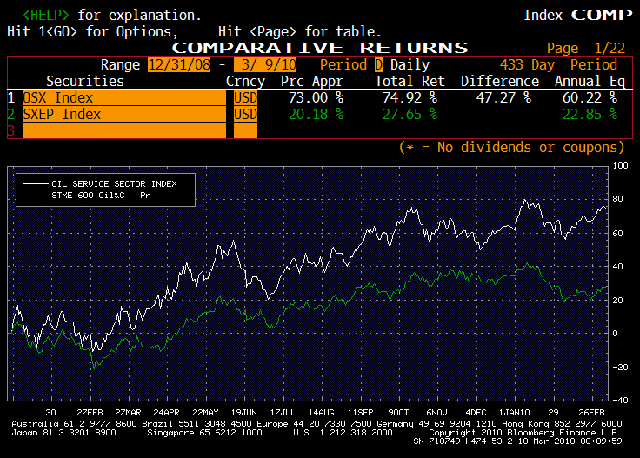 (Article published in Spanish in Cotizalia on 11/03/10)
(Article published in Spanish in Cotizalia on 11/03/10)
In the last twelve months the merger and acquisition activity in the oil world has accelerated. $45 billion in acquisitions so far, and this only just begun.
In this environment, I have seen little written in the press on oil services companies. And meanwhile, investors lose money by investing in large integrated oil, which is like watching grass grow. However, it’s in services where the opportunities might be.
Let me be concise. Big Oil’s capex is rising again. $170 billion of investments will be devoted to upstream this year globally. New contracts are being awarded to the more efficient, aggressive and flexible service companies. And if something has been demonstrated in the 2008-2009 period is that, despite the large drop in oil prices, oil service costs did not fall more than 15% over the same period. This is the proof of the power of this sector over its customers. Competition is relatively low barriers to entry and specialization is very high and oil companies (clients) do not jeopardize safety and efficiency to save a little money.
Oil services companies are the key to maximize the performance of the fields and avoid expensive delays and technical problems. And they generate spectacular returns. Groups such as Petrofac, in the UK, and Subsea 7 and Seadrill in Norway charge their customers between $200,000 and $400,000 a day for their rigs(see footnote), generating annual growth of over 10% on their backlog.
Also, it’s worth mentioning the companies that specialize in large complex projects. Among the latter, Halliburton and Schlumberger have proven their ability to carry out giant projects from Saudi Arabia to Nigeria and generate very strong returns. In Spain, a much more modest play is Tecnicas Reunidas, an example of performance and competitiveness.
U.S. companies have woken up and now seek to attack the juiciest segment of the oil market: large contracts to exploit giant fields, both in deep water (Gulf of Mexico, Brazil) and the three that open borders for the coming decades : Alaska, Iraq and West Africa.
We have seen the recent deals between Schlumberger and Smith International, followed by Baker Hughes and BJ Services, and the market is already beginning to speculate about the possibility of a merger between Halliburton with Weatherford. If the latter merger is completed, be prepared to witness the creation of a genuine global leader. Meanwhile in Europe, it is rumored that Seadrill could buy Pride.
For the uninitiated investor, let me recommend that if you’re interested,you should concentrate on the following three characteristics:
– A Company’s ability to maintain or increase their prices to customers and increase its order book. This is a highly specialized industry and the weak fish die quickly.
– Avoid semi-state owned and over-diversified firms that often face execution risks, or are too dependent on one customer.
– Focus on independent and well capitalized companies with expertise in a specific segment that is of interest to predators. From my point of view, these are the deep-sea drilling and seismic companies.
The service sector is an area for investors with risk appetite who want exposure to oil prices, as one of the few sub-sectors that generates double-digit growth and high margins in the oil world. As the world continues to need $170 billion dollar annual investment in oil and gas, and I think we have many years ahead like this, oil service industry leaders will maintain the capacity to increase margins and orders.
Note:
Land Rig: manufacturing cost $10-15 million, then hired for $ 15-20.000/day
Jack up: Cost of production $75-175m, then hired for $ 100-200.000/day
Semi submersibles: Cost between $200-400 million, then hired for $ 200-400.000/day
Drill ship: Cost of construction: $300 – $500 million, then hired for $ 250-500.000/day